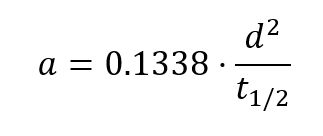Thermophysical Parameters
The specific heat capacity cp, thermal diffusivity a, and thermal conductivity λ are important thermophysical properties for characterizing the heat conduction of materials.
Different measuring methods are available depending on the material to be analyzed, the measuring temperature, and the accuracy required.
How Laser-Flash Analysis Works
Laser flash analysis is often used to primarily examine solids and liquids in small sample quantities. It conforms to the standards ASTM E1461, DIN EN 821, and ASTM C714. The method dates back to Parker et al., who developed the analysis in 1961 to measure the three thermophysical properties cp, a und λ.
The principle of laser flash analysis is based on a vertical application of energy to the bottom side of the sample. The time offset between the energy input on the bottom side of the sample and the energy output on the top side of the sample is used to determine the thermal diffusivity of the sample material.
Since thermal diffusivity depends on temperature, the sample is heated to the desired temperature in an oven; the subsequent measurement is then carried out using an isothermal process. To that end, the bottom side of a sample is exposed to a short pulse of energy (xenon flash lamp or laser).
The energy absorbed causes a temperature increase in a thin layer on the surface of the sample. This rise in temperature spreads throughout the sample, so that a temperature increase also occurs on the top side of the sample, which is recorded by an infrared detector as a function of time.
If the thickness d (in cm) of the sample is known, the thermal diffusivity a (in cm2/s) can be calculated from the chronological sequence of the temperature rise based on the analytical temperature rise function using the following formula:

However, this calculation does not reflect a loss of heat by the sample or a duration of the energy pulse that is not infinitely short. As a matter of fact, part of the heat supplied is lost through radiation, convection, or through heat dissipation into the area surrounding the sample. These effects were corrected through various mathematical processes such as iterative approximation solutions and are implemented in special evaluation software so that ultimately, the laser flash method delivers very precise measurement results over a wide temperature range.
Determining Cp through Laser-Flash Analysis
Through the correlation

the specific heat capacity of the sample can then be determined through

If the density of the sample material is also determined, it is possible to calculate λ using the correlation.
Furthermore, the specific heat capacity can be determined using dynamic differential scanning calorimetry (DSC).
